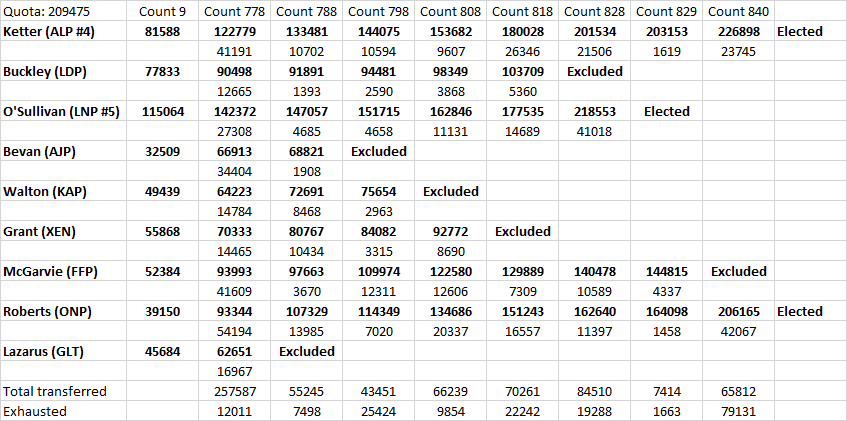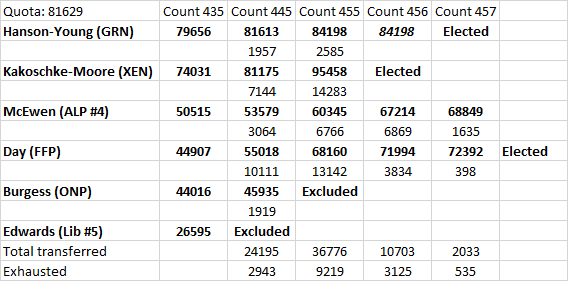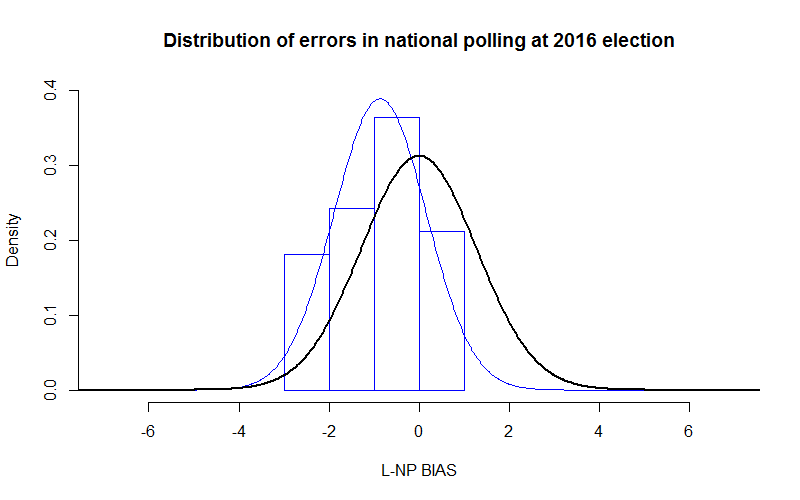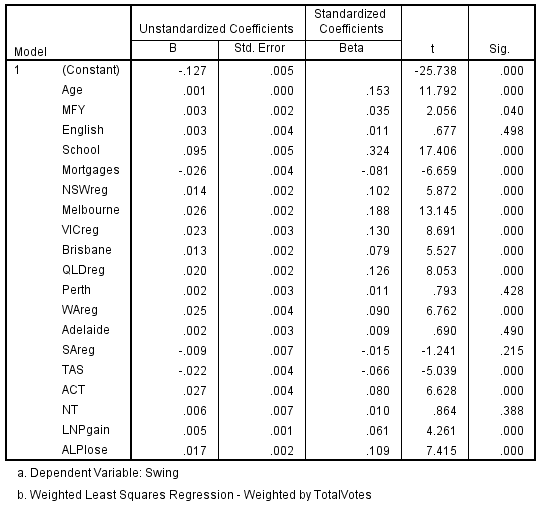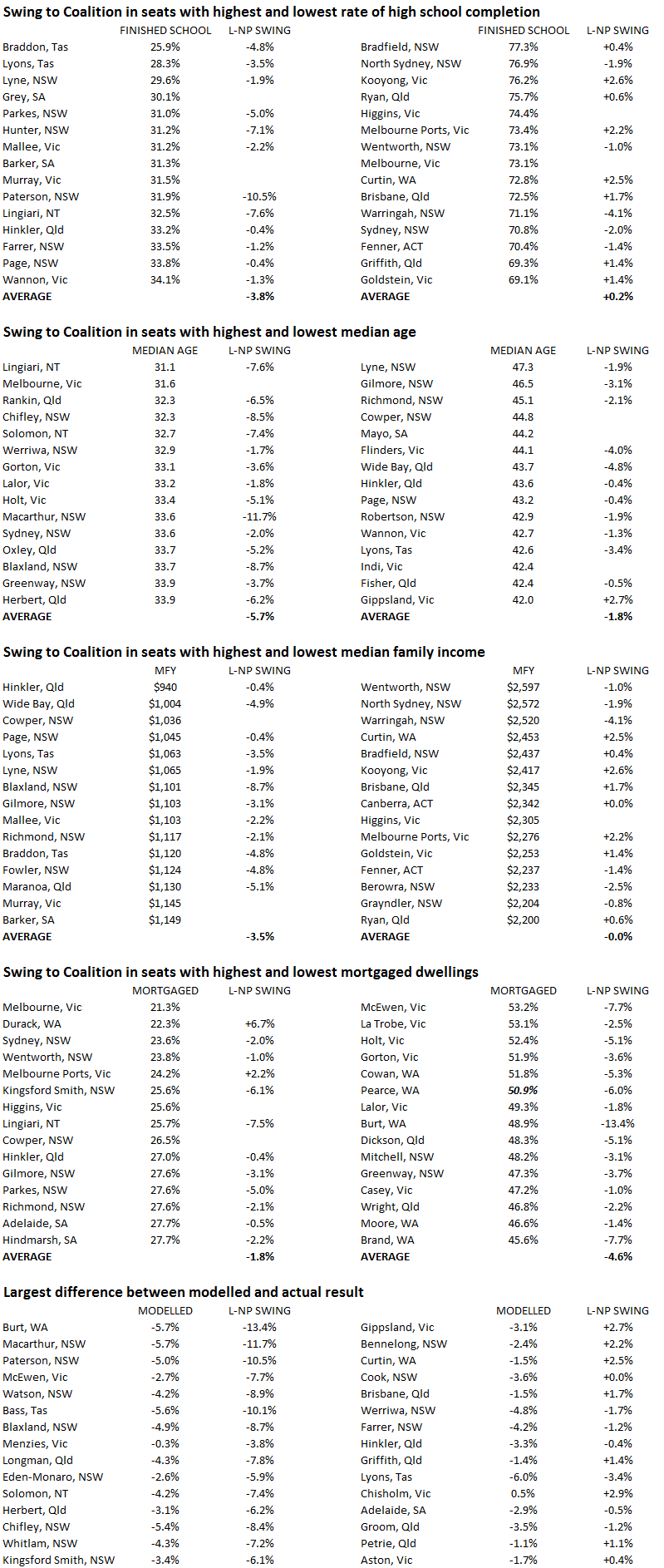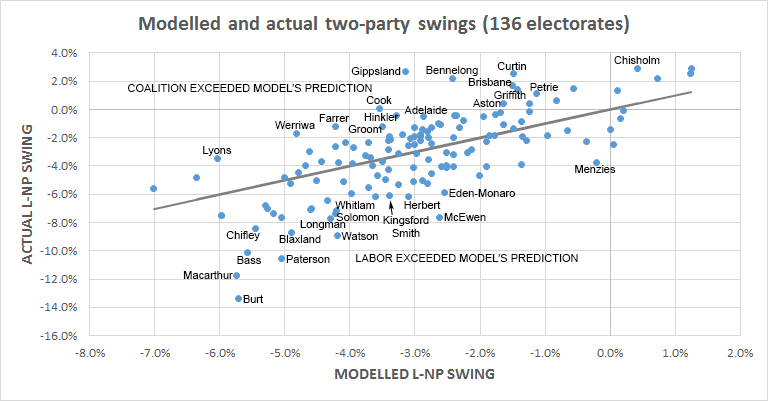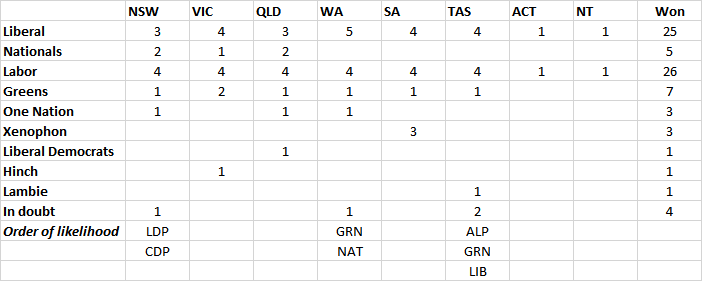Tuesday night
Somewhat unexpectedly, the Australian Electoral Commission has announced it will proceed immediately to a recount in Herbert, despite its own policy saying it should first conduct a formal distribution of preferences to confirm that the margin is below the 100-vote threshold that triggers an automatic recount. According to the AEC press release, the decision was made “after judging that the margin between the two leading candidates, after a full distribution of preferences, would remain firmly in the scope of a requirement for a recount”. Criticism of the slow pace of the count may well have influenced the decision, with the press release hinting that its August 8 deadline for returning the writ may also have been a factor. There will now be another primary vote count with a concurrent two-party count, followed at last by the full distribution of preferences that will formally decide the result. The AEC says this will start tomorrow and “is expected to take approximately two weeks”.
Monday night
There was a remarkable turn of events in Herbert as the final declaration votes were mopped up, with Labor’s Cathy O’Toole drawing to an eight-vote lead over LNP incumbent Ewen Jones at the conclusion of the indicative two-party preferred count. This included 76 provisionals breaking 40-36 to Labor, 63 absents breaking 34-29 to Labor, 57 out-of-division pre-polls breaking 36-21 to Labor, and 28 postals breaking 16-12 to the LNP. Fairfax reports an AEC spokesperson saying a decision will now be made “whether to have a recount or a distribution of preferences”, but the AEC published a recount policy two years ago that makes it rather clear that it should follow the latter course. The next stop would thus be the exclusion of last-placed candidates and the distribution of their preferences until only two are left standing, which will surely mean O’Toole and Jones.
In theory, this should conclude with O’Toole eight votes ahead, but it may be that the process turns up anomalies. If a final margin of less than 100 votes is confirmed, as seems all but certain, the entire process will be repeated with a full recount (although it would certainly be a lot quicker than the first count, since we are no longer awaiting late-arriving votes and processing declaration votes). It’s entirely possible that one of the two processes could switch the result. A recount after Clive Palmer’s win in Fairfax at the 2013 election increased his winning margin from 36 to 53; at the 2007 election, in the seat of McEwen at Melbourne’s northern fringe, a seven-vote winning margin for Labor on the first count flipped to a 12-vote win for the Liberals on the recount, which then became a 27-vote win after the Federal Court adjudicated on disputed ballot papers in response to a Labor legal challenge.
Sunday night
The AEC says yesterday was spent checking declaration votes in Herbert against the electoral roll, allowing for all outstanding votes to be counted tomorrow. So I’ve marked the occasion by bumping this thread to the top of the page. Presumably there’s longer to go in Hindmarsh, where the number of unprocessed declaration votes is much higher. The chart below projects the results for both seats based on estimates of the outstanding number of formal votes and the existing two-party vote shares for each vote type. The “conversion” column refers to the rate at which processed declaration votes ended up in the tally as formal votes, and this is applied to the number of unprocessed votes to estimate the number of formal votes outstanding, which is displayed over the next two columns. On this basis, Labor stands to claw back two votes from its 12-vote deficit in Herbert, while increasing its margin in Hindmarsh (note I have had to work off 2013 numbers here for provisionals, since none have been counted yet). Very clearly though, Herbert could go either way, and we will have to await the preference distribution and a recount to be clear one way or the other.
Meanwhile in Melbourne Ports, Kevin Bonham relates he has been “sent a scan of an indicative 3CP throw which shows Danby outlasting Hodgins-May by 802 votes”. This all but confirms that the Greens will be excluded before Michael Danby, who will go on to overtake the Liberals on Greens preferences and retain the seat.
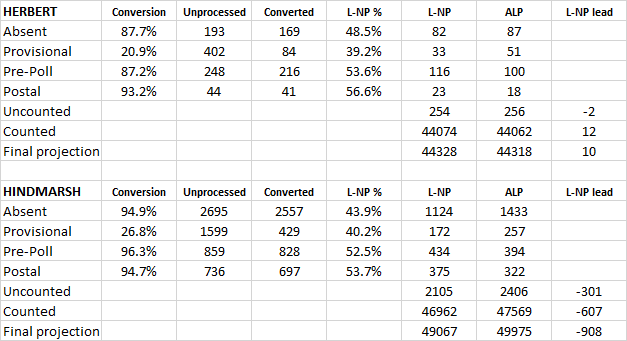
Friday night
The number of votes left outstanding is small enough that there is probably not much to be gained from maintaining the projections. Herbert is still as tight as can be, and the count in Hindmarsh remains painfully slow, with hardly anything of substance having happened since Monday. In Herbert today, the first counting of provisionals favoured Labor 93-60, and a small batch of postals favoured the LNP 84-76. Overall, the LNP lead was cut from 44 to 12. “Envelopes awaiting processing” include 446 provisionals, 399 out-of-division pre-polls, 200 absents and 44 postals. That won’t necessarily amount to that many votes being admitted to the count, particularly in the case of provisionals. It would seem that 100 provisionals are likely to be added, which on past form would give Labor a net gain of 20. The LNP has had 53.6% of out-of-division pre-polls and 56.6% of postals so far, and Labor 51.6% of absents, suggesting the other outstanding votes are more likely to favour the LNP. Ultimately though, there is little enough in it that anything could happen, including the result coming out differently when the distribution of preferences is conducted, or in the recount that is likely to follow.
Thursday night
For the second day in a row in Herbert, a big correction in Labor’s favour on pre-poll voting centre rechecking — this time from the Townsville centre — delivered a boost for Labor (Labor up 10, LNP down 101) that almost compensated for ongoing tide to the LNP on postals (554-460, although the last batch added favoured Labor 143-129) and out-of-division pre-polls (232-204). The combined effect was to stretch the LNP’s lead from 34 all the way out to 44. Based on the rate at which declaration votes issued translated into formal votes cast in 2013, I can’t see there’s much counting left to be done apart from late-arriving postals and, in the big hope for Labor, provisionals. Provisionals are few in number, with only 289 entered into the count in 2013, but almost invariably favour Labor. It’s probably discouraging for Labor that only 1134 provisionals have been issued compared with 1720 in 2013, but there may be a different dynamic this time for whatever reason. Still slow progress in Hindmarsh, with pre-polls favouring the Liberals 351-318, which does little to disturb a projected Labor winning margin of around 600.

Wednesday night
The LNP finally hit the lead today in Herbert, and in doing so have brought the “total ahead” tally in line with “total projected”. This happened despite a revision of the total at the Kirwan pre-poll centre putting Labor up by 83 and the LNP down by 65. The LNP lead is at 34, which is projected to increase by 100 or so in what remains to be counted. It was another slow day of counting for the second tightest seat, Hindmarsh, where rechecking cut the Liberals by 60 votes and Labor by 14.
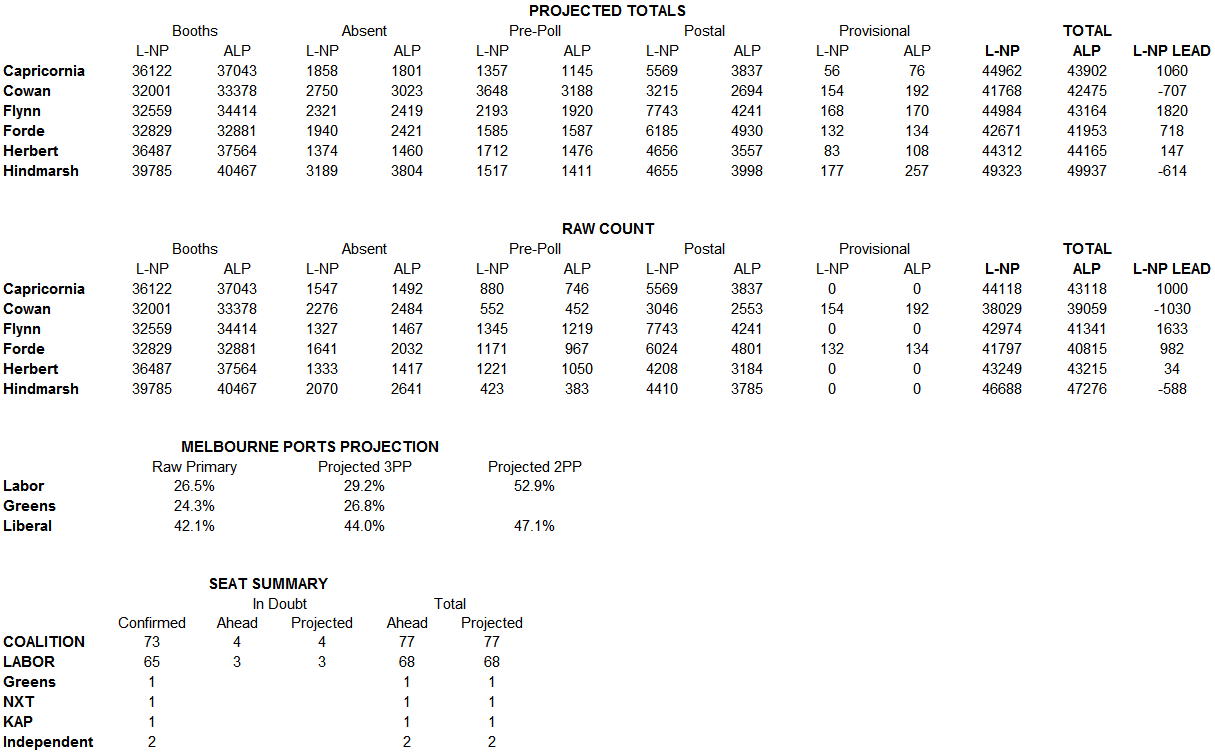
Tuesday night
The only seats still of interest are Herbert and, arguably, Hindmarsh — the table below will continue to follow all designated counts, but the commentary will stick to those two. Labor’s raw lead in Herbert wore down from 178 to 66, with absents breaking 811-787 to Labor and out-of-division pre-polls going 423-329 the other way. The model’s projected winning margin for the LNP is up from 103 to 230. All that happened today in Hindmarsh was ordinary vote rechecking that cost the Liberals 30 and Labor 31.
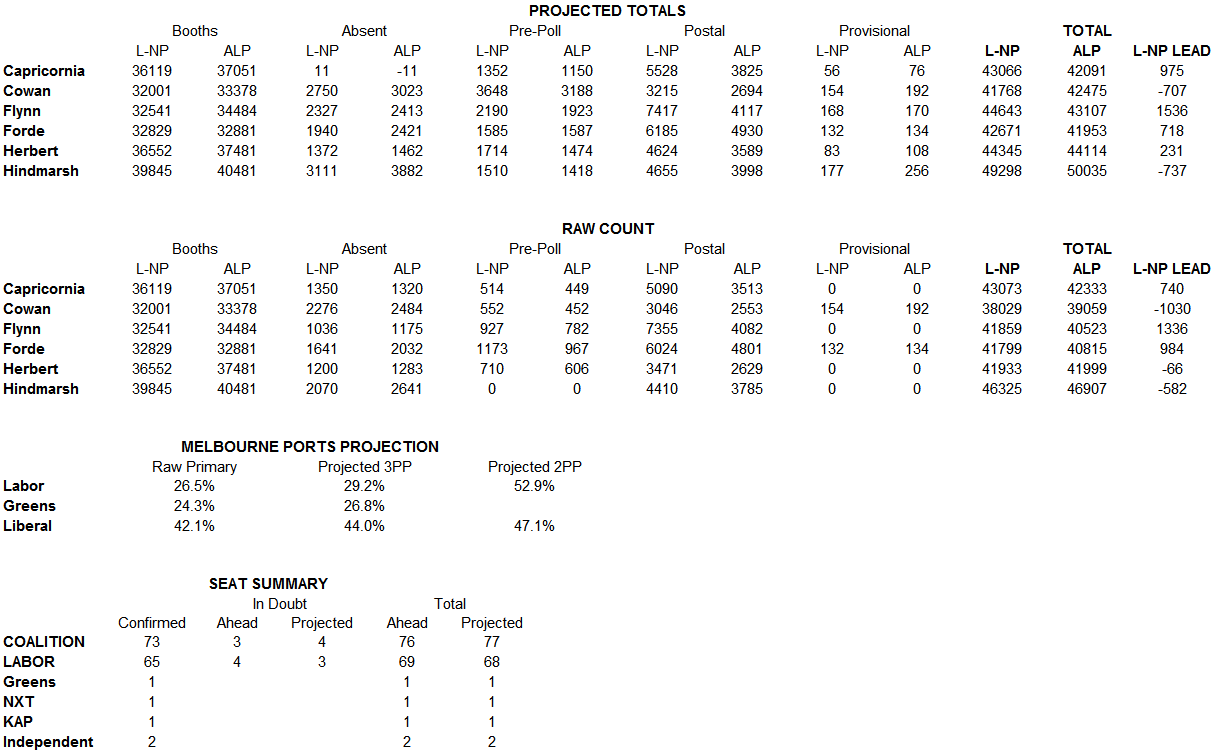
Monday night
The ABC computer rang up a seventy-sixth win for the Coalition today in Capricornia, while Labor claimed victory in Cowan. Labor also looks increasingly likely to take Hindmarsh, and increasingly unlikely to take Forde. That just leaves Herbert, which continues to go down to the wire.
Capricornia. The LNP’s grip strengthened today, to the extent that the ABC today credited as the decisive seventy-sixth seat confirmed for the Coalition. Added to the count today were 2434 postals and 1485, both of which were in line with a projection that points to an LNP winning margin approaching 1000 votes.
Cowan. Labor claimed victory today after rechecking apparently turned up a pile of Greens preferences misallocated to the Liberals at the Tapping booth. Labor also got 55.8% from a batch of 2127 absents, although the first 1004 out-of-division pre-polls went 54.9% the other way. Labor’s raw lead has blown out to 946, which comes down only slightly on the projection.
Flynn. I’m now projecting an LNP winning margin of 0.85%.
Forde. The LNP winning margin is 0.57%, which I project to come down to 0.37%.
Herbert. The LNP continues chipping away at Labor’s raw lead, which is down from 302 to 178 after postals went 561-435 to the LNP, and the first out-of-division pre-polls went 287-277.
Hindmarsh. A big batch of 3781 absents gave Labor an anticipated fillip by breaking 54.7% their way, while another 1032 postals broke almost evenly. Labor’s lead has pushed out from 273 to 583, and looks unlikely to be reversed.
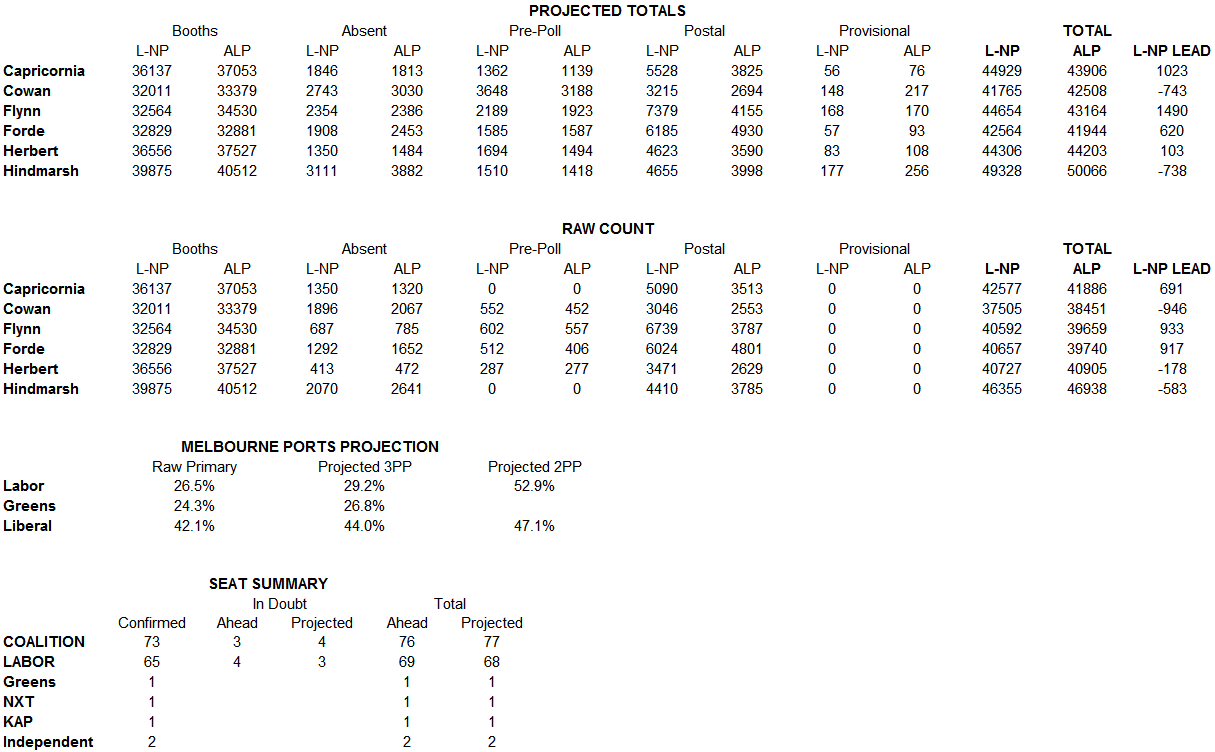
Sunday night
Only a small amount of counting conducted today:
Cowan. The odds of a Labor victory shortened a little further with 573 postals reversing the earlier trend in breaking 53.6% to Labor. The raw lead is now 513, which if anything seems likely to widen after the remaining absents are counted. That leaves the Liberals banking on a better-than-expected result on out-of-division pre-polls.
Flynn. Just ordinary vote rechecking today, but it turned up a significant anomaly at the Wondai booth, where the LNP gains 54 votes and Labor loses 71.
Hindmarsh. Not sure why, but the absent count went backwards today. I haven’t incorporated the change in the result published below.
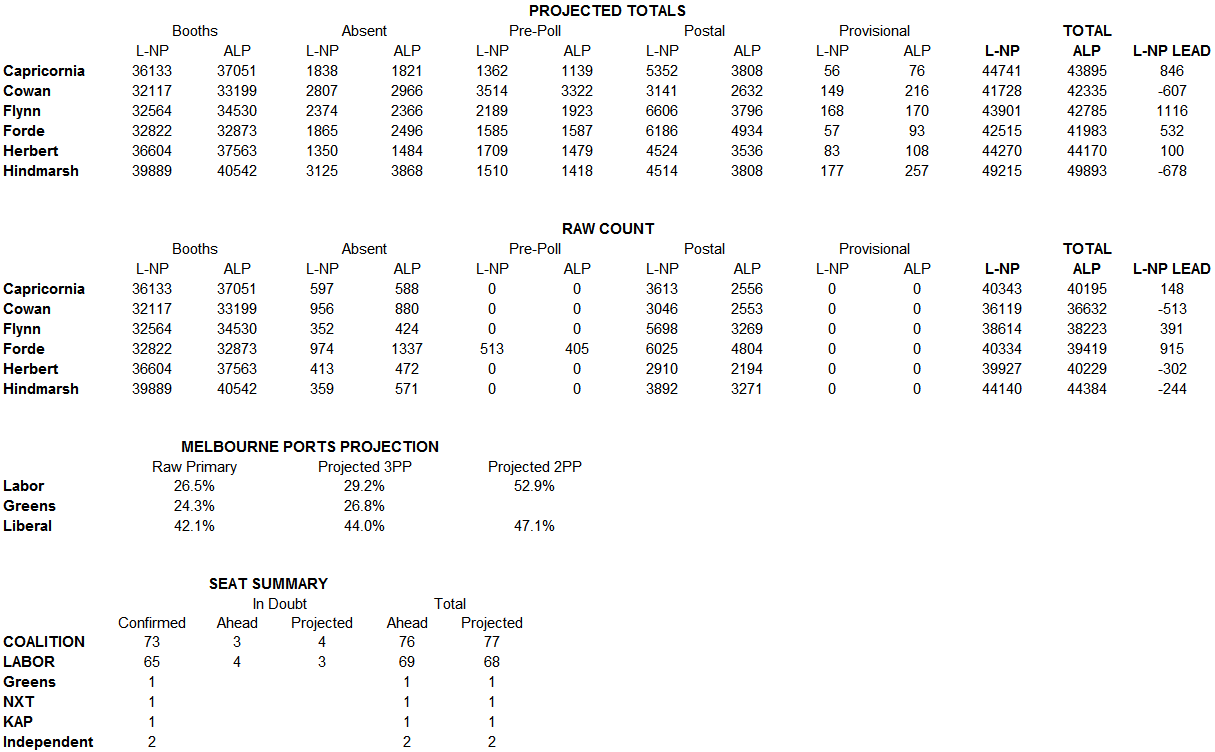
Saturday night
The Coalition moved into the lead on the raw count today in Capricornia and Flynn, which the projection has long tipped them to win. That just leaves Herbert with Labor ahead on the raw vote and behind on the projection, and the result there looks tighter than ever after today’s counting.
Capricornia. The LNP has hit the lead on the raw count following a particularly good day today on postal votes, gaining 62.5% out of 1273. The first 1185 absents were lineball, in line with the projection. Very hard to see the LNP losing from here.
Cowan. A second batch of absents calms Labor nerves by breaking 54.3% in their favour, having evidently been drawn from a more favourable area than yesterday’s batch. Ordinary vote recounting has results in a net loss to Labor of 27.
Flynn. The first 776 absents break 54.6% to Labor, but they continue getting crushed on postals, the latest 1561 of which broke 61.7% to the LNP. That turns yesterday’s seven vote deficit into a 266-vote lead, although their projected winning margin is to three figures.
Forde. The LNP scored 56.6% out of 1268 postals and 55.9% from the first 918 out-of-division pre-polls, although Labor continued to dominate absents on a second batch of 2311, breaking 57.3% their way. The ABC is now calling this for the LNP.
Herbert. A slightly better day for Labor, who got 53.3% from the first batch of 885 absents, and had their lowest losing margin so far out of five days of postal vote counting, with the LNP getting 54.8% out of 970. However, both results were right on a projection that has the LNP headed for a winning margin of around 300.
Hindmarsh. A second batch of absents has followed the first in going heavily to Labor, who score 59.1% out of 528. The only other change today was ordinary vote rechecking, which gives Labor a net loss of 26.
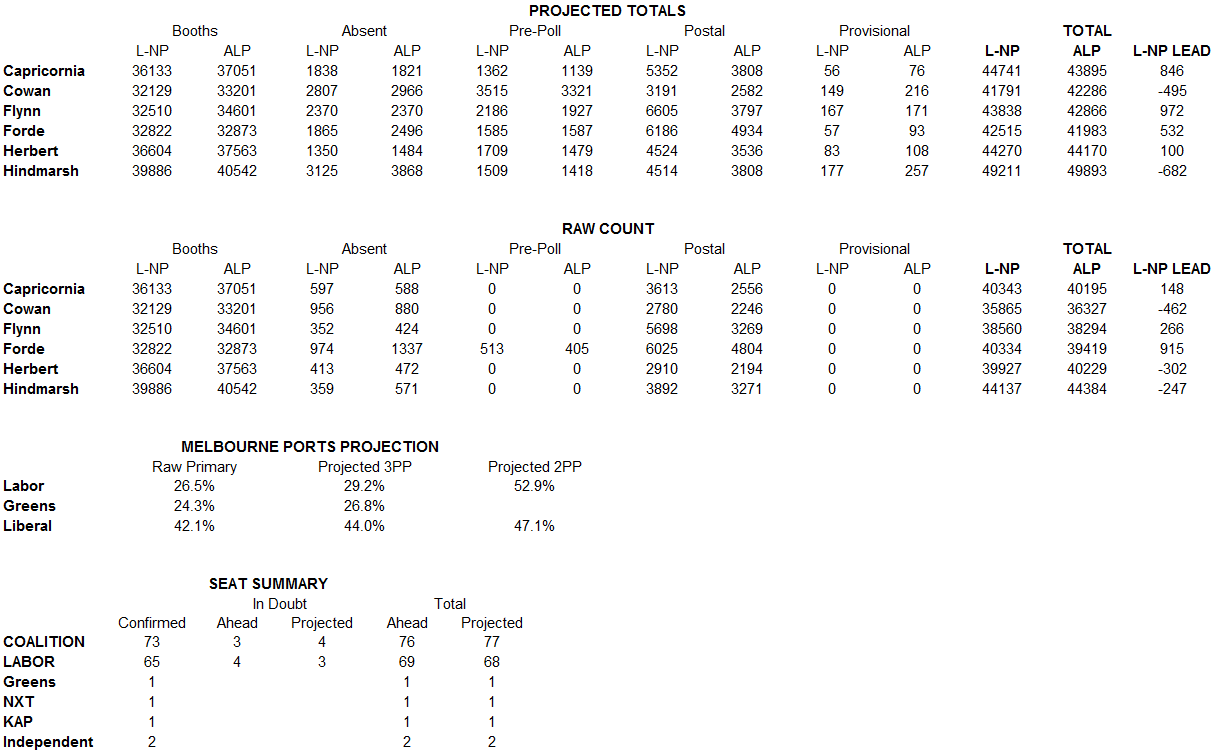
Friday night
Of the four lineball seats in Queensland, the Coalition continues firming steadily in Capricornia, Forde and especially Flynn, while Herbert seems very slightly more likely to land their way as well. They have also had a fillip from the first absent votes in Cowan, but caution should be taken in extrapolating from this. The most likely Coalition total is 77, but Herbert could potentially lower it to 76.
Capricornia. Today’s batch of 1464 postals went 60.1% to the Coalition, making them more like yesterday’s 59.2% than Wednesday’s 54.4%, and bringing the total postals counted so far right in line with the projection. While Labor retains a raw lead of 175, that’s not going to be nearly enough to withstand 4000 outstanding postals breaking at least 57-43 to the LNP. There are still no absents or out-of-division pre-polls in the count, but the 2013 precedent suggests they will be respectively neutral and favourable to the LNP.
Cowan. The Liberals had a boost when they scored 56.2% out of the first 1108 absent votes, but the behaviour of absents can be highly variable between batches, and it may be that this one simply came from booths just outside the boundary at the seat’s Liberal-leading western end. Certainly Labor would hope so, because the Liberals will be on track for a win by about 350 votes if this result was borne out over the remaining 4500 or so absents. Ordinary vote rechecking gave Labor a net benefit of 31 votes. Nothing else added today.
Flynn. What I suggested might be a trend of diminishing returns on postals for the Coalition has proved not to be, with today’s batch of 1954 going 67.1% their way, and around 3000 still outstanding. Labor’s raw lead is now just seven votes, and the projected Coalition winning margin is in four figures. Still no absents or out-of-division pre-polls though.
Forde. The first batch of 1331 absents broke heavily to Labor, by 775-556, but not to an extent wildly out of line with the projection. Today’s batch of 3113 postals, which leaves at most around 2000 outstanding, also behaved predictably in breaking 55.0% to the Coalition. The Coalition’s raw margin was up from 687 to 783, which the projection has coming down to about 500 due to the trend to Labor on absents.
Herbert. Another 962 postals behave similarly to previous batches in breaking 56.8% to the Coalition, leaving their projected winning margin at a fragile 211. Still no postals or out-of-division pre-polls, so this one is still very much up in the air.
Hindmarsh. The only new counting today is the first batch of absents, and while there are only 402 of them, they bear out the notion that absent votes will settle the deal for Labor, breaking 64.4% in their favour.
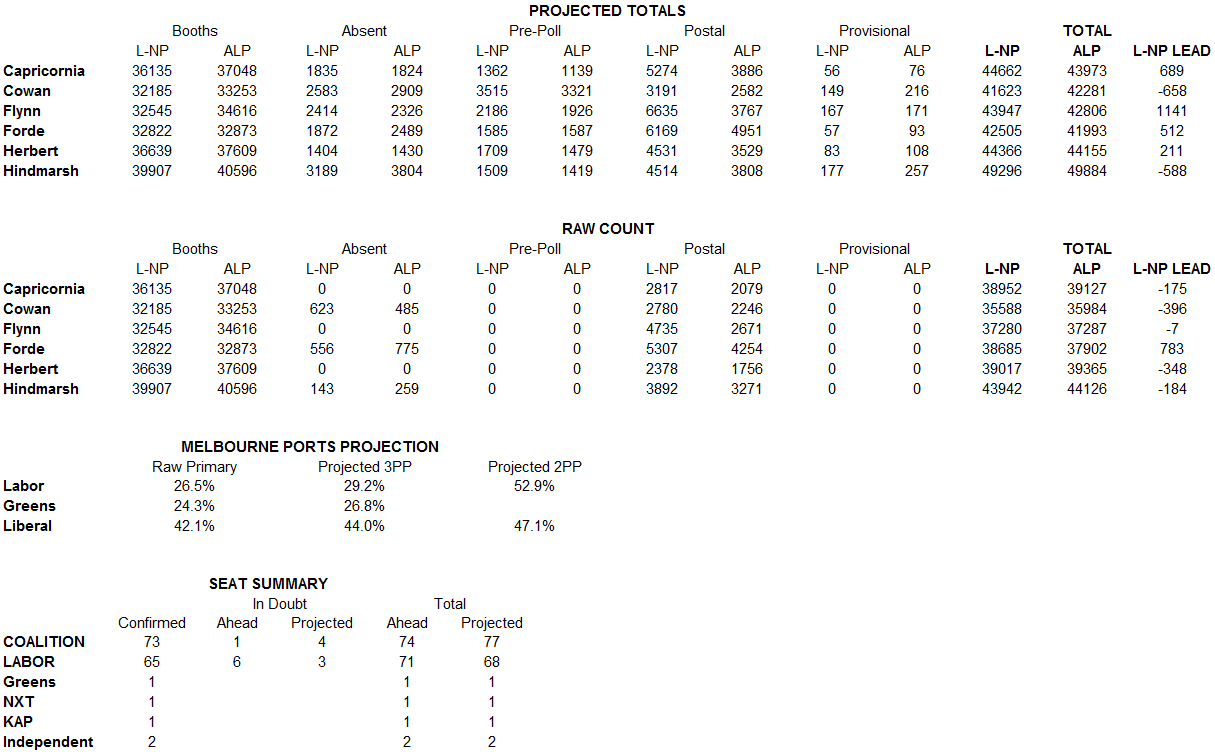
Thursday night
Now that postals are in in very substantial numbers, I’ve tweaked the model so that outstanding postals are determined half with reference to the count so far, and half from the difference between postals and ordinary results from 2013, rather than just the latter as before. This makes a substantial difference in only one seat, but the exception is important, as it pushes the Coalition up to 77. That seat is Herbert, where the strong show from the Coalition on postal votes had worn the projected Labor margin down to 54 before the adjustment was applied. The first absent votes have begun being counted, but so far not in any of the seats that matter.
Capricornia. Yesterday I noted that the first batch of 1948 postals from Capricornia was the first I’d observed in which the Coalition fell below the projection. That hasn’t been repeated in today’s batch of 1484, which in breaking 59.2% to the Coalition have brought the overall postals total to exactly where the projection had it. Ordinary vote rechecking added 40 votes for Labor and 24 votes for the Coalition. The overall picture is little changed on yesterday, with the LNP projected to win by between 500 and 600. The raw vote is catching up with the projection, with Labor’s lead down from 732 to 476.
Cowan. Good news and bad news today for the Liberals. The bad news came from ordinary vote rechecking, which knocked 112 from the Liberal total and 30 from Labor’s. The good came from a second batch of 1367 postals, which cut the raw Labor lead from 701 to 534 by breaking 59.1% in the Liberals’ favour. This compares with 53.9% from yesterday’s batch of 1386 and 54.8% as credited to them in the projection. However, there are too few postals outstanding for this to constitute a trend that might offer them encouragement, and Labor remain favoured to win.
Flynn. I’ve been a bit cautious in my commentary about Flynn, given the mismatch between the raw results and my projected totals. But the longer the count goes on, the better the projection of an LNP victory looks. A third batch of postals was added today, this time accounting for 1949 votes, and the LNP received 62.8% of them, cutting Labor’s lead on the raw count from 927 to 646. However, there’s at least some encouragement for Labor in that the Coalition has trended downwards over the three batches added so far, from 65.3% to 64.2% to 62.8%, with around half still outstanding. Even so, the projection leaves the Coalition with a final lead of 970 — a fair bit higher than yesterday due to an error I made when increasing the projected total number of postal votes.
Forde. A big batch of 3905 postals were added today, and they continue to land bang on the projection, in this case at 55.5%, increasing the LNP’s raw lead from 265 to 687. I’ve also revised upwards the anticipated number of postal votes up fairly substantially, which increases the projected LNP winning margin from 164 to 552.
Herbert. A second big batch of postals, this time 4247 of them, wasn’t quite as good for the Coalition as yesterday’s, but still caused Labor’s raw lead to come down from 620 to 449. As noted in the introduction, the methodological tweak now results in the LNP making it over the line, such that Labor will need above-projection results on absents and pre-polls to stay in front.
Hindmarsh. The Liberals poked their nose in front for a brief time today on the raw count, but the projection continues to take the view that absents will bring home the bacon for Labor, having favoured them by 4.0% relative to ordinary votes in 2013. The Coalition is slightly outperforming the projection on postals, today’s batch of 1443 breaking 55.0% in their favour, but not by enough to do the job for them without a substantially above-projection result on absents. Rechecking of ordinary votes also caused the Liberals to suffer a net loss of 60.
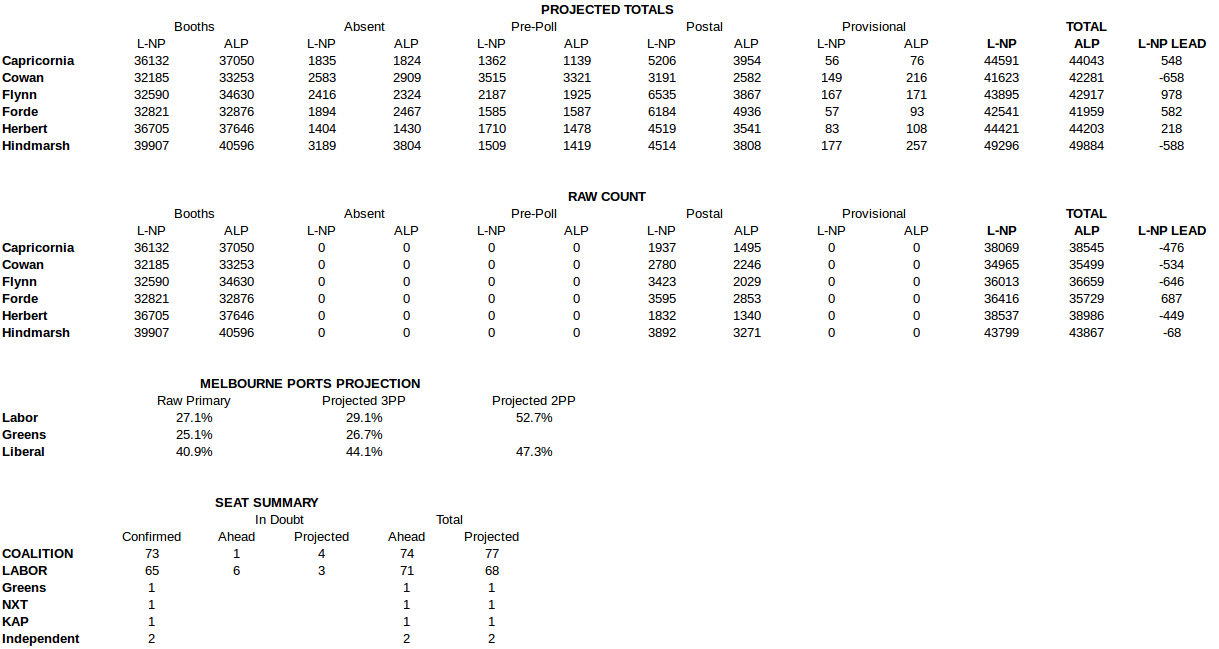
Wednesday night
I’ve scratched Petrie, Gilmore, Dunkley, Chisholm and Grey from my watch list, with all of them called for the Coalition. Cowan and Hindmarsh appear likely to be won by Labor, but they are still on the watch list for now. That leaves four seats that are highly doubtful, all of them in Queensland — Capricornia, Flynn, Forde and Herbert, suggesting a range of possible final outcomes for the Coalition from 74 to 77. I’ve changed the estimated number of postal votes cast based on the AEC’s data for number of votes cast, with the adjustment in each case being upwards. Since postal votes favour the Coalition, this has been to their advantage in each case, though not to the extent of changing any leads. Knowing how variable the daily pattern of postal vote counting can be, I am continuing to estimate that outstanding postal votes will differ from ordinary votes as they did in 2013, rather than projecting them off the postals count so far at this election, which might be thought a little generous to Labor.
Capricornia. The first batch of postals was finally added today — 1948 out of what should be around 9000 — and they are the first lot where the Coalition has underperformed the projection, breaking 54.4% rather than 57.6%. Since I’m continuing to use projections based on the 2013 pattern for uncounted postals, this is one seat where the projection might well be too favourable to the Coalition. In short, this is very much too close to call.
Cowan. Postals are still closely matching the projection, today’s batch of 1386 breaking 731-655 to Liberal. Both the raw and projected Labor winning margins have consistently been at around 700, so there will need to be surprises in store on absents and out-of-division pre-polls for Labor to lose.
Flynn. The LNP continues storming back here on postals, with today’s batch breaking 1748-989 their way, slicing the raw lead from 1686 to 927, and maintaining the projected LNP winning margin of over 500. Labor nonetheless maintains a raw lead of 927, and thus certainly shouldn’t be written off. The seat is now finally on the ABC’s seats in doubt list.
Forde. This one remains lineball, with the first 2543 postals well in line with the projection, with 56.1% going to the LNP. There remain an estimated 5000-plus postals to be counted, so a change in the trend would make a substantial difference to the final result. Rechecking of ordinary votes has delivered Labor another hit, for a net loss of 60.
Herbert. The second batch of postals is much like the first, breaking 1261-940 in favour of the LNP, so the presumption that outstanding postals will follow the 2013 pattern is probably flattering Labor. Since the projection credits them with a fragile lead of 272, this seat remains very much in play.
Hindmarsh. The second batch of postals consisted of 1426 votes, of which 54.2% went to the Liberals, in line with both the previous batch and the projection. Further counting of postals could well put the Liberals into the lead, but Labor will do a lot better on absents and look likely to gain the seat.
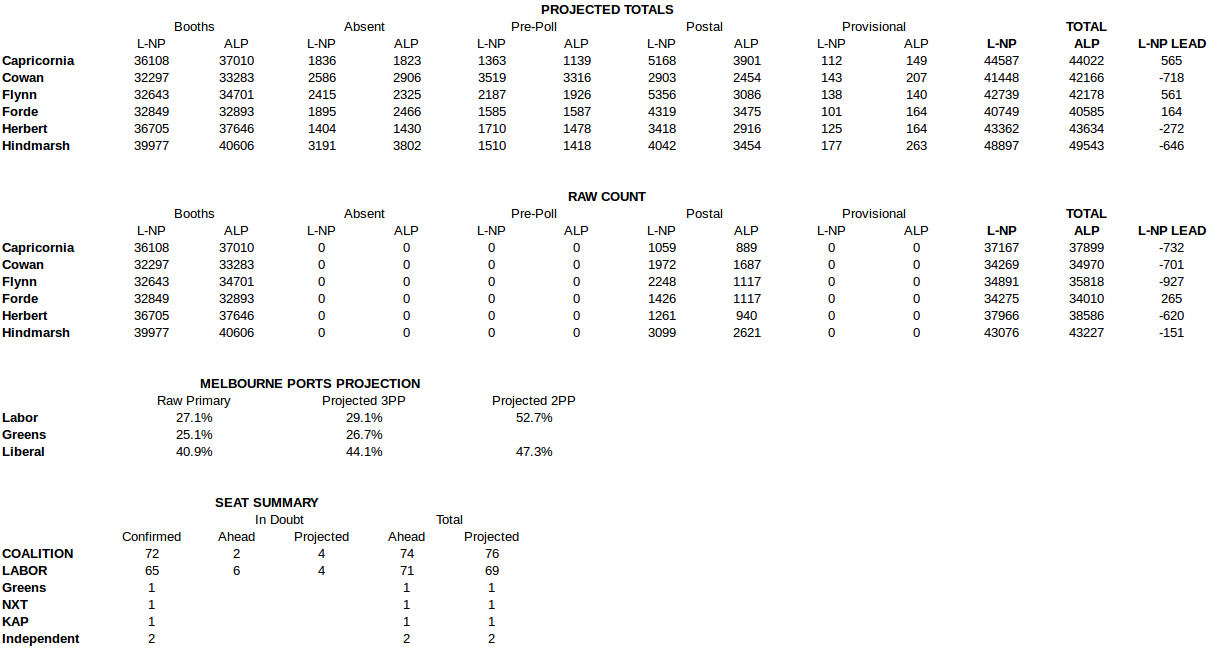
Tuesday night
The first day of post-election counting in earnest has brought slow and patchy progess, but such news as there has been has been uniformly good (or at the very least, better) for the Coalition. In the seats on my watch list, batches of postals have been added for five seats, and in each case they find the Coalition outperforming the projections I published yesterday. The final seat projection now has the Coalition inching over the line to a majority, thanks to a subtle change caused by rechecking in the lineball seat of Forde, although obviously there’s still nothing in it. Furthermore, Grey is now a firm inclusion on the list, and I’m less inclined to hedge the inclusion of Flynn with qualifications. In turn:
Capricornia. Rechecking of ordinary votes turned up nothing of consequence.
Chisholm. Already a likely Liberal gain, the Coalition received 57.3% from the first 1956 out of what should be about 11,000 postals, compared with my projection of 55.2%. Nothing of consequence on rechecking of ordinary votes.
Cowan. No new counting.
Dunkley. A slight change was made to the result from one of the pre-poll voting centres, but otherwise nothing doing.
Flynn. There are only 766 of them, from what should be a total of about 8500, but the LNP outperformed a postal vote projection I was wary about crediting yesterday — 16.8% better than ordinary votes, compared with 14.5% in 2013.
Forde. Rechecking produced a net gain of 51 for the LNP, which wouldn’t ordinarily amount to much, but this one is so close it’s caused the projected winner to change.
Gilmore. One bit of good news for Labor is that rechecking gave them a net improvement of 52, although they’re still behind on both the raw and projected results.
Herbert. The LNP’s chances of chasing down their deficit look to have improved after they picked up 58.2% from the first 1333 out of what should be about 6500 postals, compared with the 52.2% projected yesterday. What looks to have been partial rechecking of ordinary votes turned up nothing of interest.
Hindmarsh. Good progress here in counting of postals, accounting for 4294 from what should be a total of around 7500. The result is the closest of the bunch to yesterday’s projection, coming out at 53.5% compared with 53.1%. A very small amount of ordinary vote rechecking was also done.
Petrie. The Special Hospital Team votes were added to the count, which is something my projections yesterday didn’t account for in any way, and they’ve broken 1265-797 in favour of the LNP. Given the ordinary vote total is used as the baseline for calculating declaration vote, this also causes the latter to shift in the LNP’s favour. The LNP also got 56.8% from 683 out of what should be around 8000 postals, compared with yesterday’s projection of 53.1%.
Grey. The NXT needed about 75% of preferences to overhaul the Liberals here, but with two-party counts now conducted in 34 out of 124 booths, they’re only getting 58.3% of them. I expect I’ll be taking this one off the watch list pretty soon.
Melbourne Ports. No new counting.
Fully updated accounting below — click on image to enlarge.
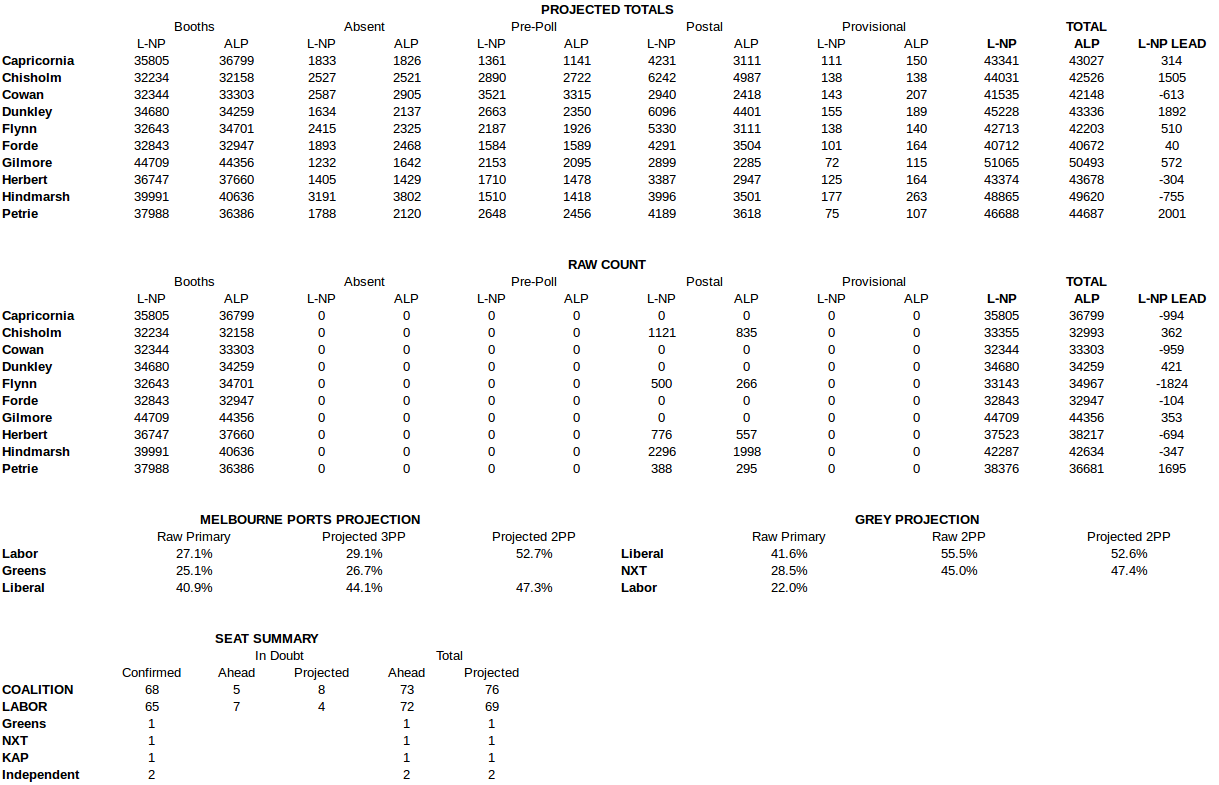
Sunday
With counting of postal votes finally set to crank up today, this thread will be used to crunch the numbers and project results in the crucial late phase of the count. Below is a detailed accounting of how the situation will look if the various types of declaration vote behave as they did in 2013, relative to the ordinary vote results. Some guess work has also been required to estimate the total numbers of each type of vote cast. The relevant data from the AEC is patchy at present, but from what’s available I’ve estimated that out-of-division pre-polls will be up 44%, postals down 6% and absents unchanged. For reasons stated in the previous post, I’m a little more dubious about this exercise in Flynn than I am in the other electorates, so I’m not willing to state with confidence that Labor’s current 2058 vote will indeed disappear there – but nor do I think Labor is anything like as comfortable there as that total suggests. With Flynn currently included in a projected total of 75 seats, this is no small matter. Click on the image below to enlarge.

